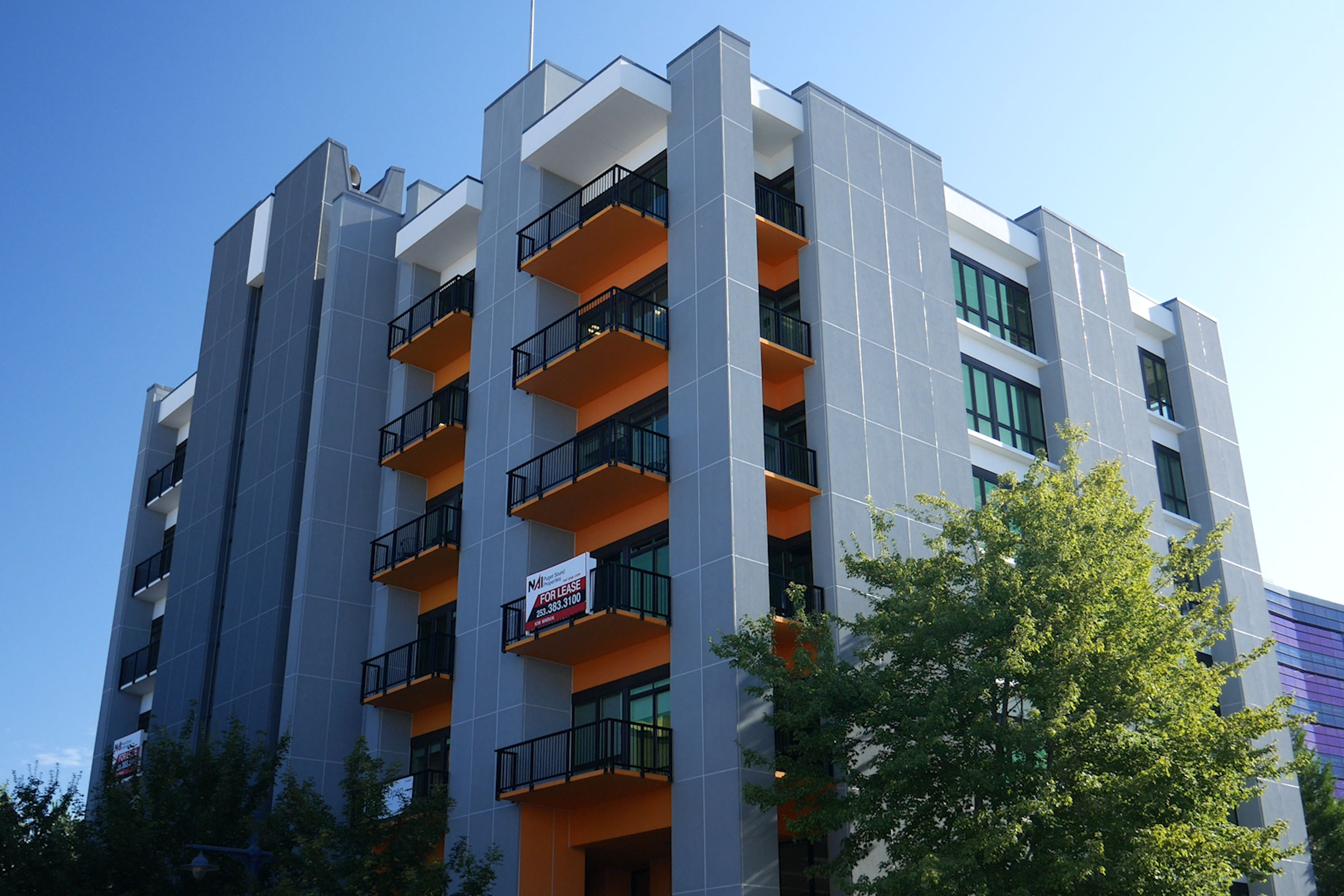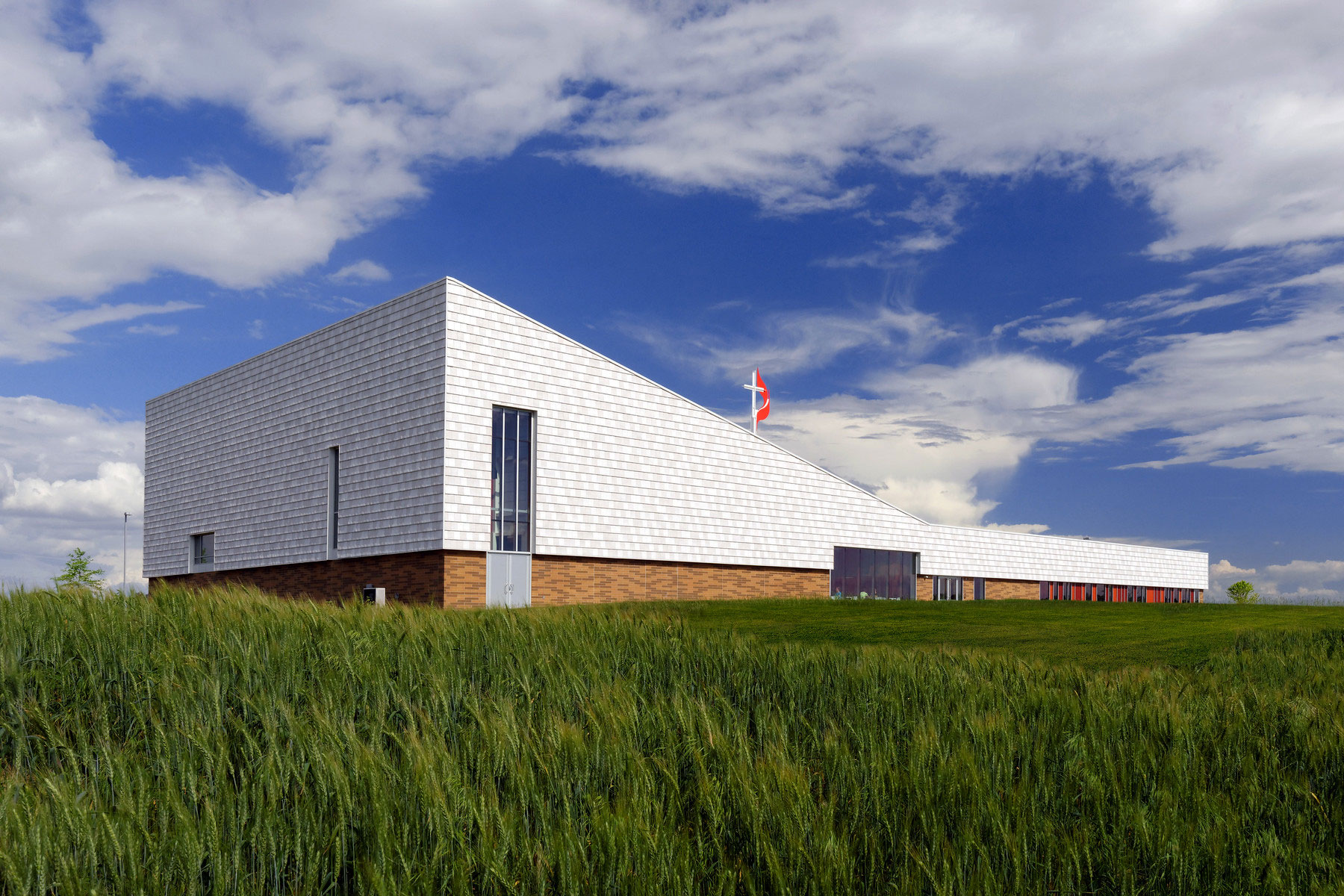Story at a glance:
- Climate responsive architecture is designed with local weather patterns in mind to reduce energy needs.
- Most climate responsive buildings implement elements of passive solar design and utilize passive ventilation strategies.
- Implementing climate responsive architecture on a large scale is key to mitigating the effects of climate change.
In 2022 the built environment was responsible for producing 14.6 gigatons of carbon dioxide, making it one of the largest contributors of greenhouse gas emissions and a driving force of climate change. With severe, climate change–induced weather events increasing in frequency each year, the need for resilient, energy-efficient architecture has never been more apparent.
To achieve this some of today’s common architectural designs have to be adapted in favor of designs that reflect for the changing world of weather conditions. To reduce energy demands from heating, cooling, and powering built structures, architects must utilize passive design strategies informed by a project site’s unique environmental characteristics. In short, we must prioritize climate responsive architecture.
What is Climate Responsive Architecture?

The Exploratorium’s move to Pier 15 provides a prime waterfront location for this internationally acclaimed museum of science and perception. The complexity of the program was matched by the challenge of rehabilitating an existing historic structure in the most energy-efficient manner possible. To that end, the building takes advantage of the original pier building’s natural lighting and the water of the Bay for cooling and uses materials that are both sustainable and durable enough to withstand a harsh maritime climate. The result is the country’s largest Net Zero Energy museum. Photo by Bruce Damonte
In the fundamental sense climate responsive architecture is the architectural approach that focuses on designing energy-efficient buildings uniquely suited to the climate in which they are constructed. These buildings’ designs are informed by, and reflective of, local weather conditions.
By taking into account things like seasonality, solar pathing, natural shading, ambient humidity, and annual rainfall patterns, climate responsive buildings and infrastructure work with, rather than against, the local climate to provide maximum occupant comfort using the least amount of energy possible. This is achieved in large part through the careful and strategic implementation of passive design strategies.
This approach is also crucial in preparing towns and cities for the increasing frequency of severe weather events linked to climate change. It was only within the last century or so that many traditional architectural practices were abandoned in favor of universal architectural designs that typically fail to take into account local climate factors—something many architects are beginning to see the pitfalls of.
“Increasingly architects and designers are realizing that building designs need to reflect the conditions of the area in which they are located,” Prasoon Shrivastava, CEO and founder of Prasoon Design Studio, previously wrote for gb&d. “For example, buildings in warm climates should utilize tinted windows to cool off the space, rather than air conditioning units.” In designing with local climatic factors in mind, architects are able to both reduce their projects’ carbon emissions and create healthier spaces for their clients, Shrivastava says.
Why is Climate Responsive Architecture Important?

HMTX Industries’ new world headquarters is set to become Connecticut’s greenest building when it opens in Norwalk in 2022. Photo courtesy of HMTX Industries
As our world continues to suffer the consequences of advanced climate change, we must radically rethink the way in which the built environment is designed. New construction projects should be designed to withstand extreme weather events while also contributing as little as possible to the very factors responsible for changing climate patterns—namely the burning of fossil fuels and destruction of carbon-sequestering natural resources.
Emphasizing climate responsive architecture is important because it addresses both of these concerns. As one of its core principles, climate responsive design prioritizes passive heating, cooling, and ventilation strategies—all of which reduce a building’s energy consumption and carbon emissions. Climate responsive architecture also seeks to construct buildings that are capable of surviving the natural disasters endemic to a region, as this reduces the amount of energy, money, and resources spent on repairs or rebuilding entirely.
All in all, climate responsive design is important because it ultimately helps reduce carbon emissions, limits waste production, and creates safe, long-lasting structures.
Benefits of Climate Responsive Architecture
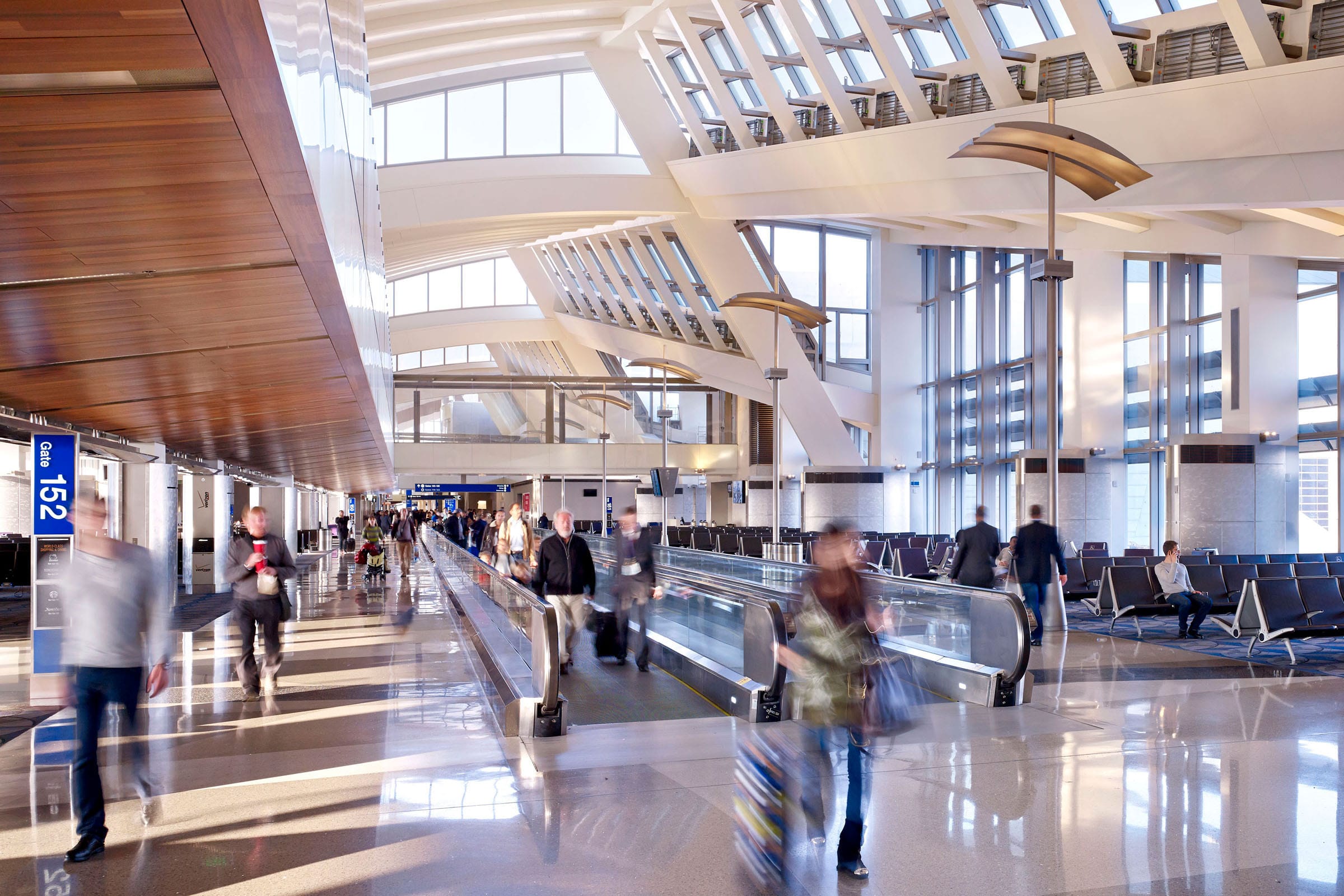
Inspired by the Pacific Ocean, the Tom Bradley International Terminal’s site-responsive roofline optimizes building performance by reducing solar glare and heat from the ocean from the west and bathes the terminal in natural light from the northeast. Photo by Nick Merrick
Designing climate responsive buildings is beneficial for a variety of reasons, for both the individual and the planet at large.
Environmental Sustainability
One of the main benefits of climate responsive architecture is that it helps facilitate environmental sustainability. Climate responsive buildings achieve this by improving energy-efficiency, conserving water, reducing carbon emissions, and protecting natural resources through the prioritization of low-carbon and low-impact materials.
Because they are built to respond to and withstand local climatic conditions, climate responsive structures also have a longer operational lifespan, which helps reduce material waste and prevents further resource extraction.
Reduced Operating Costs
One of the hallmarks of climate responsive building design is the use of natural, passive systems—e.g. natural ventilation, daylighting, and passive solar heating—in place of active, mechanical ones. These passive systems rely on natural phenomena rather than electricity to function and therefore significantly reduce a building’s energy consumption, resulting in greatly reduced energy-related operating costs.
Extensive implementation of passive systems in climate responsive buildings can reduce energy consumption by as much as 90%.
Enhanced Occupant Comfort & Productivity
When passive systems are implemented correctly with regard to local climatic conditions, climate responsive buildings provide improved occupant comfort—and even enhance productivity—compared to those buildings reliant solely on active systems. Through the use of elements like proper insulation, passive solar design, daylighting, and natural airflow, climate responsive buildings create a pleasant, thermally regulated indoor environment all year round.
Natural daylight, for example, is crucial to maintaining the body’s circadian rhythm and has a host of both psychological and physiological benefits. “By exposing your body to daylight throughout the day, your healthy human circadian rhythm will have a significant role in regulating your sleep-wake cycle and have a positive impact on your eating habits and digestion, body temperature, hormone release, and other important bodily functions,” Neall Digert, vice president of innovation and market development at Kingspan Light + Air, wrote in a previous gb&dPRO article.
Similarly, natural ventilation provides occupants with constant fresh air, something studies have shown helps improve oxygen flow to the brain, resulting in enhanced cognitive function, concentration, and memory retention.
Improved Resiliency
I stands to reason that buildings designed in accordance with local climatic conditions boast improved resiliency over those built and constructed in a universal style without regard to the region’s environmental factors. Climate responsive buildings are better prepared to withstand both a region’s regular weather and its most frequent natural disasters, resulting in increased safety for occupants and fewer damages incurred as a result of severe weather events.
Challenges of Climate Responsive Architecture
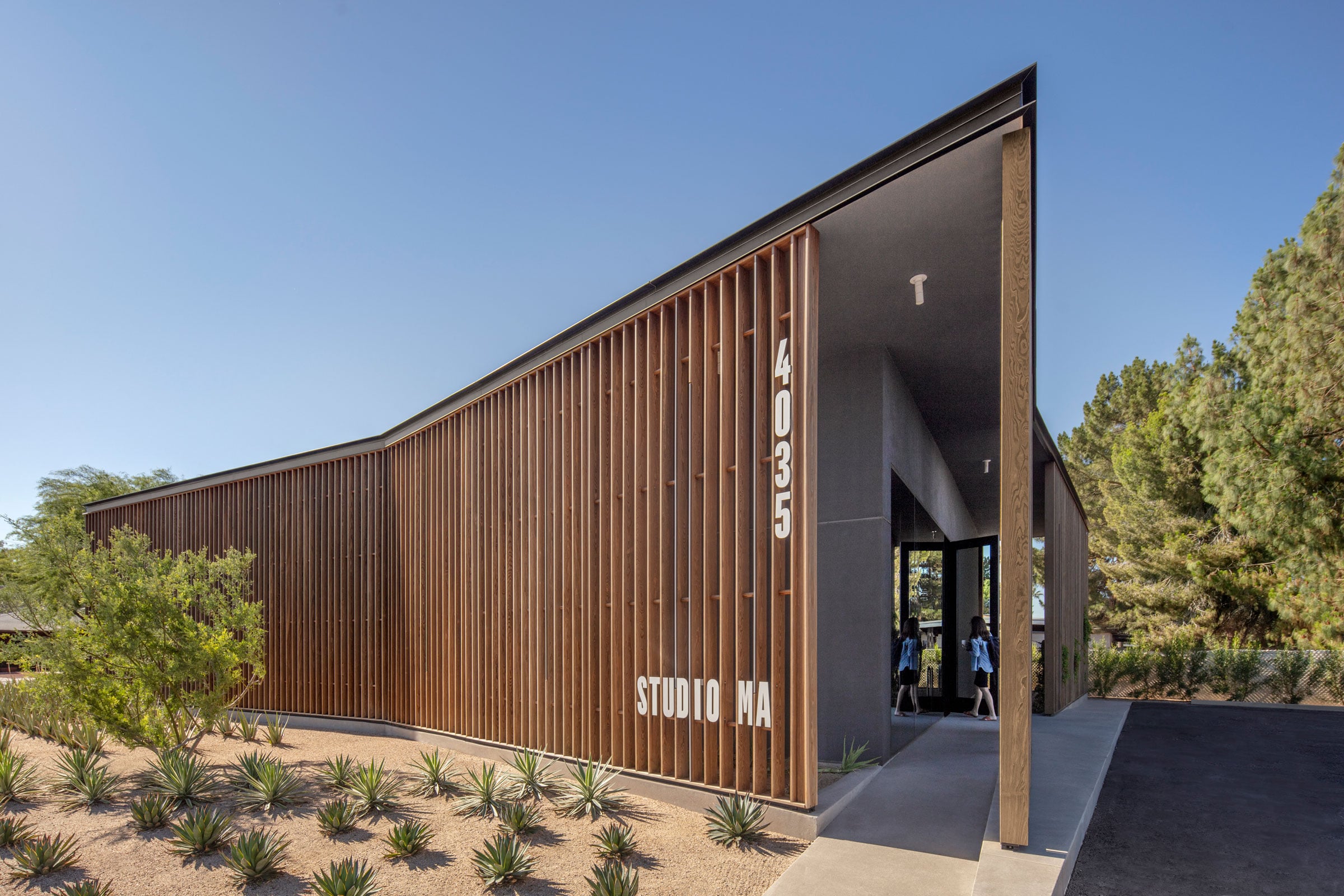
When designing their new headquarters Studio Ma wanted to include a blackwater-to-potable water recycling system, but local regulations prevented them from doing so. Photo by Bill Timmerman
Despite the numerous benefits associated with climate responsive design, this particular field of architecture is not without its challenges.
Upfront Costs
While it’s true that the cost of building sustainable, climate-ready structures has significantly decreased over the last several decades, the fact remains that the upfront costs associated with climate responsive architectural projects are still marginally higher than conventional construction projects. Climate responsive buildings are comparable in cost to those built to Passive House standards and typically cost 3 to 5% more to build on average.
This is partially due to the cost of using sustainable materials—of which there is greater competition for compared to traditional building materials—but more directly linked to the fact that climate responsive building projects typically take longer and are more complex to plan as a result of their site-specific optimization.
Regulatory Roadblocks
Building codes and regulations have come a long way with regard to HVAC energy efficiency and thermal insulation minimum requirements, but there’s still a noticeable lack of regulations in support of or incentivizing climate responsive design principles.
This is largely because most code development adoption processes operate on a three-year schedule and require all proposed changes to pass a cost-effectiveness test in isolation before they are integrated into the new code—a practice that can hinder the adoption of highly interconnected, holistic climate responsive principles that work in conjunction with one another.
To make matters worse, many decision makers in the code adoption process—or the politicians and lobbyists who have influence over a state’s building code council—do not support the updating of energy-efficiency code standards due to the misconstrued belief that such changes would drastically increase building and housing costs.
Regulatory challenges can be remedied in part by involving more sustainability professionals experienced in climate responsive design in the committees that oversee building code reevaluations.
Lack of Education & Experience
Despite being a centuries-old practice, climate responsive design in the modern era has been largely absent from the curriculums of up-and-coming architects, leaving them ill-prepared to address the growing demand for sustainable, climate-ready buildings.
This is in large part thanks to the development and proliferation of a “universal” style of architecture, of whose associated technologies (e.g. interior climate control), materials (e.g. concrete and steel), and design elements have largely supplanted many local vernacular architectural styles around the world.
Even those architects who do have an interest in pursuing climate responsive projects often find themselves facing a steep learning curve. Modern climate responsive design relies heavily on the use of various planning and preconstruction software programs, many of which require additional training before they can be mastered.
Climate responsive design also relies heavily on the integration of passive systems and use of sometimes unconventional building materials or strategies—of which construction companies, contractors, engineers, and other AEC professionals may not have adequate experience working with.
Core Elements of Climate Responsive Design
Climate responsive design may be realized in a wide variety of ways, but it is these key elements that truly tie the field of climate responsive architecture together.
Site Analysis & Integration
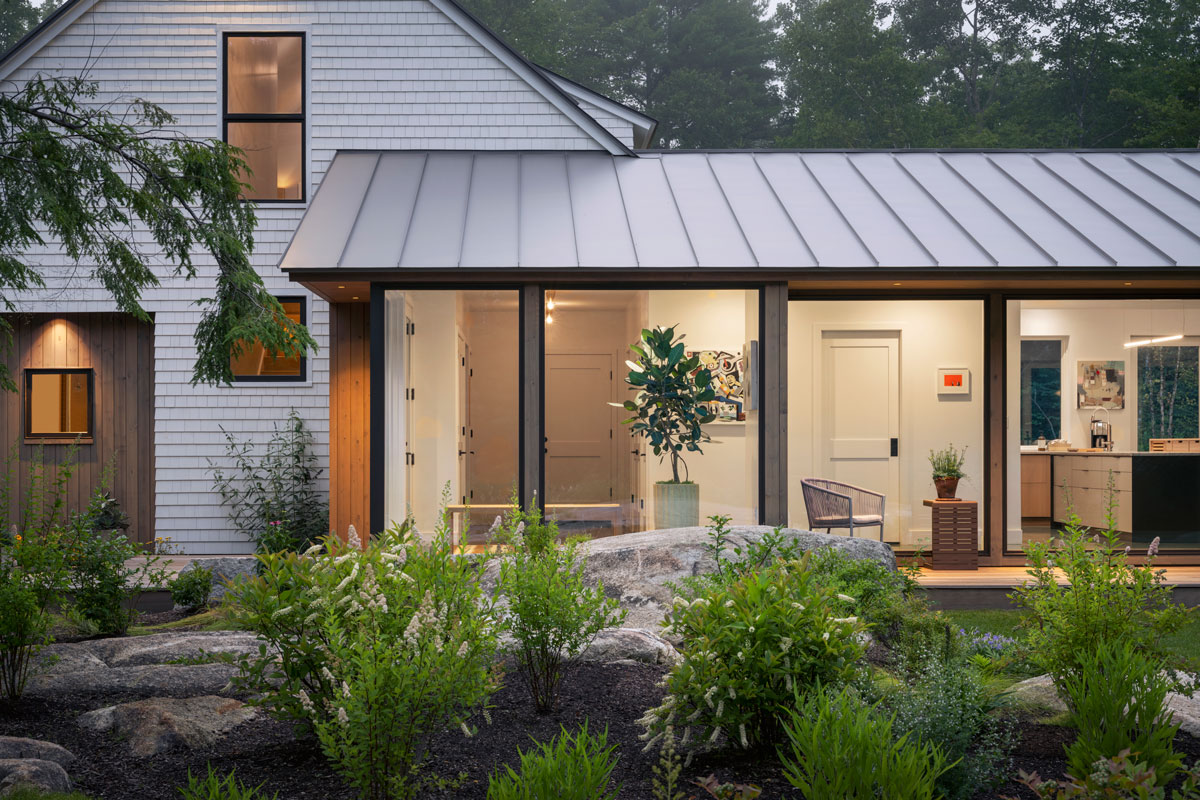
Designed by Whitten Architects, the Binnacle Hill Residence is strategically oriented to make efficient use of natural sunlight and solar energy. Photo by Trent Bell Photography
Climate responsive design starts with a thorough site analysis—that is, a detailed examination of a proposed project site’s geographical and climatic characteristics. In conducting a site analysis, architects are able to collect data on the natural topography, average annual rainfall, high and low temperatures, humidity patterns, sunlight exposure throughout the year, and more.
In knowing how these factors impact a project site, architects can make more informed design decisions as to the building’s orientation, layout, ventilation, and heating/cooling needs while also providing insight as to the types of weather events and disasters it must be able to withstand.
An in-depth understanding of the site and local environmental factors also makes it easier to integrate the building into the landscape rather than simply impose the building on top of it. In this regard climate responsive design shares some similarities with regenerative architecture.
Passive Solar Design & Energy Efficiency

Westcoat offers both solar reflective waterproofing and concrete coating systems. These systems help combat the urban heat island effect and cooling loads by lowering surface temperatures. Photo by Westcoat
To reduce a building’s electric heating and cooling loads, climate responsive architecture employs a design strategy known as passive solar design. Passive solar design seeks to use the building’s basic features—that is, windows, floors, and walls—to reflect, store, and redistribute solar heat as a means of controlling interior temperatures without the aid of mechanical systems.
By taking into account the sun’s position throughout the year, windows and sun-shades can be effectively placed so as to allow high solar heat admittance during the colder months and low solar heat during warm months.
In urban areas where shade is scarce, climate responsive architecture may make use of solar-reflective or cooling coatings—such as those offered by APV or Westcoat—on concrete and paved surfaces. When applied, these coatings help redirect sunlight (instead of absorbing it) and reduce surface temperatures, which in turn reduces energy needed for air conditioning and combats the urban heat island effect.
Passive solar design also prioritizes the use of high thermal mass flooring materials—such as stone, concrete, brick, or dirt—as these materials collect and store heat during the day and release it gradually throughout the night. When paired with proper insulation and ventilation, this heat can either be trapped during the winter or directed back outside during the summer.
Optimizing Natural Airflow & Ventilation
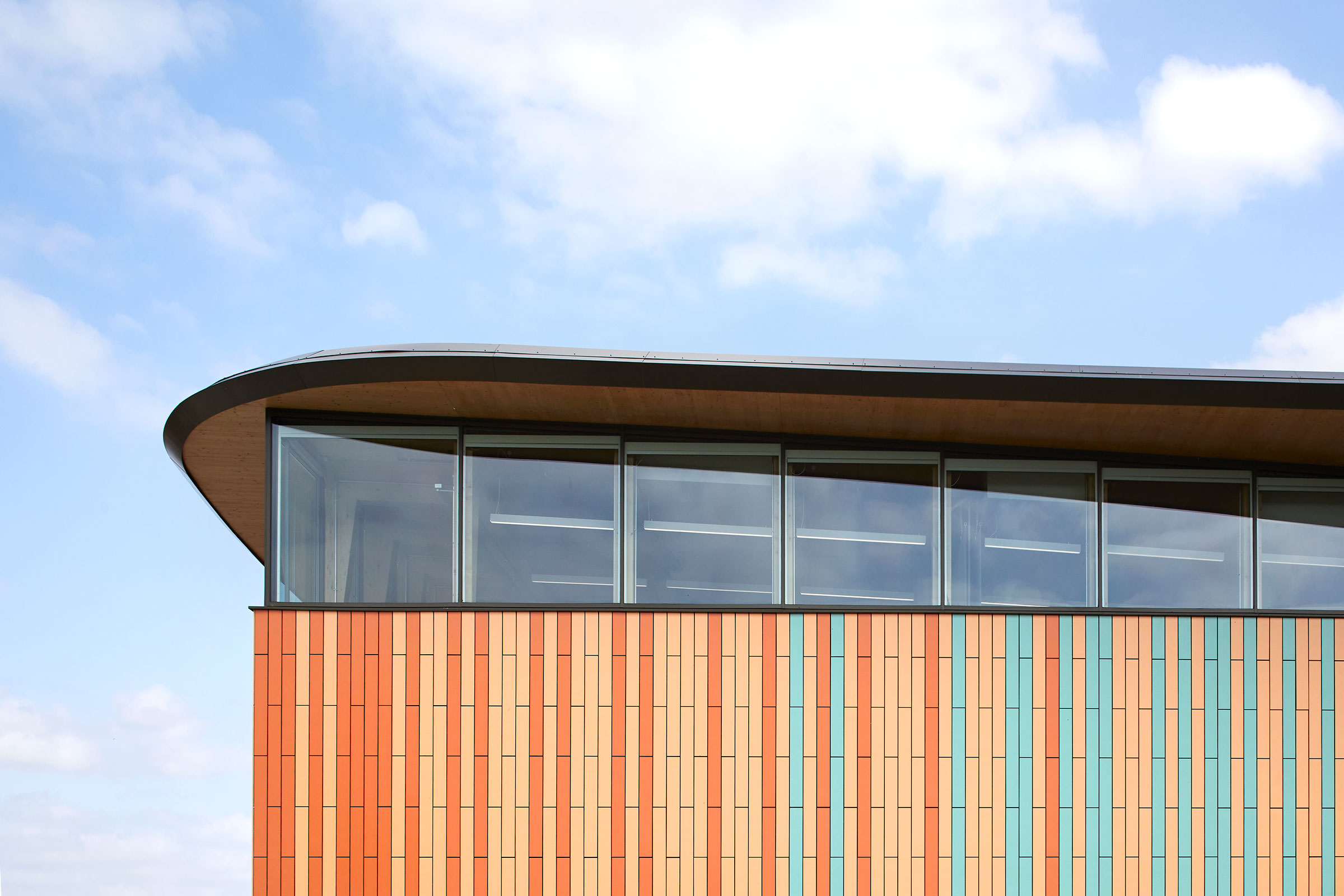
An energy-efficient envelope, passive ventilation strategies, and shading from the roof reduce energy consumption. Photo by Hufton+Crow Photography
Similarly, climate responsive architecture seeks to utilize natural airflow as much as possible while still maintaining adequate ventilation, as this too helps reduce the need for electric cooling.
Generally speaking, there are two types of natural ventilation methods: wind-driven and buoyancy-driven. Predictably, wind-based ventilation—which may or may not be paired with evaporative cooling techniques—uses natural air currents to move cool air throughout a building, whereas buoyancy-driven ventilation utilizes the differences in density between warm and cool air to create an upward airstream.
Wind-driven ventilation has a long history in traditional climate responsive architectural styles, with perhaps the most well-known being the wind towers, or badgir, of Iran, which feature openings at the top that capture prevailing winds and redirect them through ducts into a building’s interior. Similar styles of towers and wind-driven ventilation systems exist in many dry, arid climates, providing plenty of design inspiration and knowledge to draw from.
Carbon Reduction & Use of Sustainable Materials
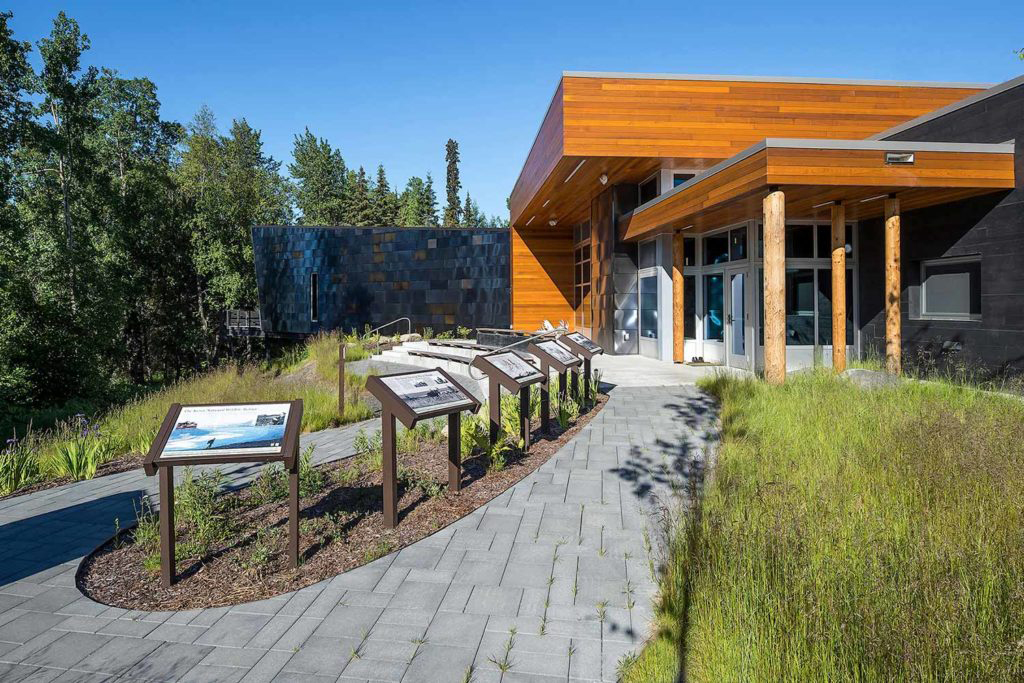
Sustainable, low-carbon building materials were used in abundance to construct the Kenai National Wildlife Refuge Visitor Center. Photo courtesy of Cushing Terrell
Climate responsive architecture aims to reduce carbon emissions by reducing the amount of energy required to heat and cool a building. In-use carbon emissions, however, only account for a portion of a building’s overall carbon footprint, as carbon is also produced to create the building materials used during construction.
For this reason climate responsive architecture attempts to use naturally sustainable building materials—e.g. earth, timber, stone, bamboo, etcetera—wherever possible, as these products typically have lower embodied carbon. Climate responsive design does not, however, seek to elevate a single or several materials to a new universal standard but emphasizes that material selection should always be influenced by local climatic conditions.
“A ‘one-size-fits-all’ approach to construction, shaped by globalized, market-driven development, often creates a mismatch between material selection and place-specific climatic requirements” Elizabeth Golden, architect and founder of Elizabeth Golden Architecture, previously wrote for gb&d.
“As a result we might find massive concrete homes in tropical climates or wood frame construction in areas prone to extreme heat and fire. This disconnect between material systems and the local environment can cause poor building performance, increase energy consumption for things like air conditioning, or contribute to a structure’s vulnerability to extreme weather events like fire or hurricanes.”
Green Features & Biophilia

Green walls and roofs featuring indigenous plant species can help absorb carbon, cool buildings, and retain rainwater. Photo by greenscreen
Plants and overall biophilic design also plays an important role in climate responsive architecture. Green roofs and walls incorporating indigenous flora, for example, are a popular design element in regions with heavy rainfall, as they help absorb water that might otherwise contribute to flooding.
Green features also help dampen sound, absorb carbon dioxide, and regulate both interior and exterior temperatures, making for more energy efficient buildings.
“Nature based solutions such as planting trees, adding green roofs and walls, maintaining natural river systems, and implementing coastal-based storm surge protection like mangroves and wetlands to combat storm surges can have a significant effect on cities,” Charlene Mortale, division vice president of project management at greenscreen, previously wrote for gb&d. “At the same time these additions provide other benefits such as cooling the street level, adding pleasurable biophilic elements to our hardscapes, and making our cities livable.”
Companies like Greenscreen make it easier for architects to incorporate green features into their climate responsive projects, especially those in urban areas where natural greenery is scarce.
Disaster Resilience

As wildfires and other severe climate events become more frequent, it becomes increasingly important to design with disaster resiliency in mind. Photo by ROCKWOOL North America
The number of weather-related disasters—be it tropical storms, tornadoes, flooding, prolonged drought, wildfires, etc.—has increased by a factor of five over the last 50 years, largely due to the effects of climate change, according to a 2021 press-release issued by the World Meteorological Organization.
Fortunately disaster resiliency is something climate responsive architecture prioritizes, as a building that can withstand severe weather events and disasters while sustaining only minimal damage is a building that requires less energy and resources to repair or rebuild.
In areas prone to wildfires, for example, climate responsive buildings should be constructed from the ground up with fire-resistance in mind. This includes obvious features like fireproof or fire-retardant wall and roof materials, but also things like fire-resistant insulation. ROCKWOOL stone insulation, for example, is naturally non-combustible and capable of withstanding temperatures up to 2,150°F—qualities that help it drastically slow the spread of fires.
“Selecting stone wool insulation is an ideal solution for the challenges of building a high-performance home in a WUI [Wildland Urban Interface] zone,” Brendan Knapman, head of product management for ROCKWOOL, previously wrote for gb&d. “It makes it possible to achieve aggressive goals for energy efficiency as well as fire resilience.”
ROCKWOOL stone insulation has an R-value that falls between 3 and 3.3 per inch, making it more efficient than most fiberglass insulations, thereby reducing a building’s HVAC energy requirements.
Climate Responsive Design Resources

HGA designed the Westwood Hills Nature Center in St. Louis Park, Minnesota to be zero energy. Photo by Pete Sieger
Knowing which design features are best suited to a particular region’s climatic conditions is often easier said than done, especially when you factor climate change into the equation. Fortunately there are a plethora of resources available to architects, engineers, and urban planners that can help make designing climate responsive structures much simpler.
1. 2030 Palette
Created and curated by Architecture 2030, the 2030 Palette is an easily browsed, all-in-one database full of relevant sustainable design principles, strategies, tools, and resources that helps architects design responsive, zero-carbon buildings capable of adapting to changing climatic conditions.
2030 Palette provides insight into how climate-responsive design principles can be implemented at the regional, city/town, district, site, and building level. All five headings are subdivided into categories of a narrower, more detailed focus; the “building” subcategory, for example, is divided into earth shading, cool roof, cross ventilation, shading devices, and so on.
These subcategories direct the user to relevant resources, websites, and tools that provide more information as to how sustainable, climate-ready development may be realized in the selected area.
2030 Palette also highlights several climate and energy analysis tools—including Sefaira, Pathfinder, SUNREL, FenestraPro, Autodesk Insight, and EDGE—that can be used in conjunction with their principles to aid in the design process.
2. cove.tools
cove.tools is a cloud-based building design software network that offers a variety of program tools that make it easier for architects and engineers to design responsive, low-carbon buildings. Of the programs they offer, two are particularly relevant to AEC professionals: the analysis.tool and loadmodeling.tool.
Cove’s analysis.tool is a state-of-the-art 3D building performance analysis and energy modeling program that helps architects optimize their projects for energy use, carbon, and cost. Features include accurate daylight simulations informed by the sDA metric, sun-hour analysis and radiation studies for passive solar design, automated energy modeling based on project location, automated embodied carbon metric calculations and estimates, and more.
The loadmodeling.tool is a whole-building energy modeling program that lets engineers precisely size, coordinate, and optimize HVAC system design for peak energy efficiency and reduced carbon emissions. Engineers can use this tool to accurately estimate a building’s monthly, daily, and hourly energy consumption as well as run energy load simulations and perform sizing calculations.
3. CLIMATESCOUT
Developed by global architecture, planning, and design firm CallisonRTKL, CLIMATESCOUT lets AEC professionals easily determine which climate responsive design principles are most suited to the particular climate zone their project resides in. CLIMATESCOUT uses the Köppen-Geiger climate classification system, which recognizes a total of 31 unique climate zones around the world based on differences in seasonal temperatures, precipitation levels, and vegetation types.
This climate map allows users to choose the location of their project, after which point CLIMATESCOUT will identify the most readily applicable building design strategies outlined in Architecture 2030’s Palette, as well as a multi-layered diagram of those strategies in action.
CLIMATESCOUT is most useful in the early pre-construction stages as it provides architects with a general baseline as to which climate responsive design strategies are most feasible. While the program is not intended to completely bypass the need for a thorough site analysis, CLIMATESCOUT does provide an overview as to the current and future environmental factors that a project must be made to withstand and respond to.
4. US Climate Resilience Toolkit
Developed by NOAA in collaboration with several other departments in the US Global Change Research Program, the US Climate Resilience Toolkit functions as both a knowledge-sharing platform and an educational hub for architects, engineers, urban planners, and the general public alike.
As the name suggests the US Climate Resilience Toolkit provides access to a variety of tools, programs, portals, and software that can be used to manage climate-related risks and enhance the design of adaptable, responsive development projects. The toolkit also gives users access to a broad assortment of case studies as well as region-specific data on climate hazards, cultural responses, and best practices for facilitating climate resilience.
The US Climate Resilience Toolkit is also host to the National Environmental Modeling and Analysis Center’s Climate Explorer, a novel program that offers maps, graphs, and data downloads of both observed and projected climate variables for every county in the United States.
5. Climate Change World Weather File Generator
Developed by the University of South Hampton’s Energy and Climate Change Group, the Climate Change World Weather File Generator—or CCWorldWeatherGen—is an online resource that gives architects and engineers the ability to generate climate change weather files for virtually any location on earth.
CCWorldWeatherGen uses model summary data pulled from the IPCC’s Third Assessment Report’s HadCM3 A2 experiment ensemble to transform contemporary or ‘present day’ EnergyPlus Weather (EPW) files into climate change TMY2 or EPW files.
Once converted these files are compatible with most building performance simulation programs and allow architects to glean a better understanding of how local climatic conditions might impact or otherwise influence the overall efficiency and operation of the buildings they design.
Examples of Climate Responsive Architecture
Here are a few global examples of climate responsive architecture.
Niamey 2000, Niamey, Niger
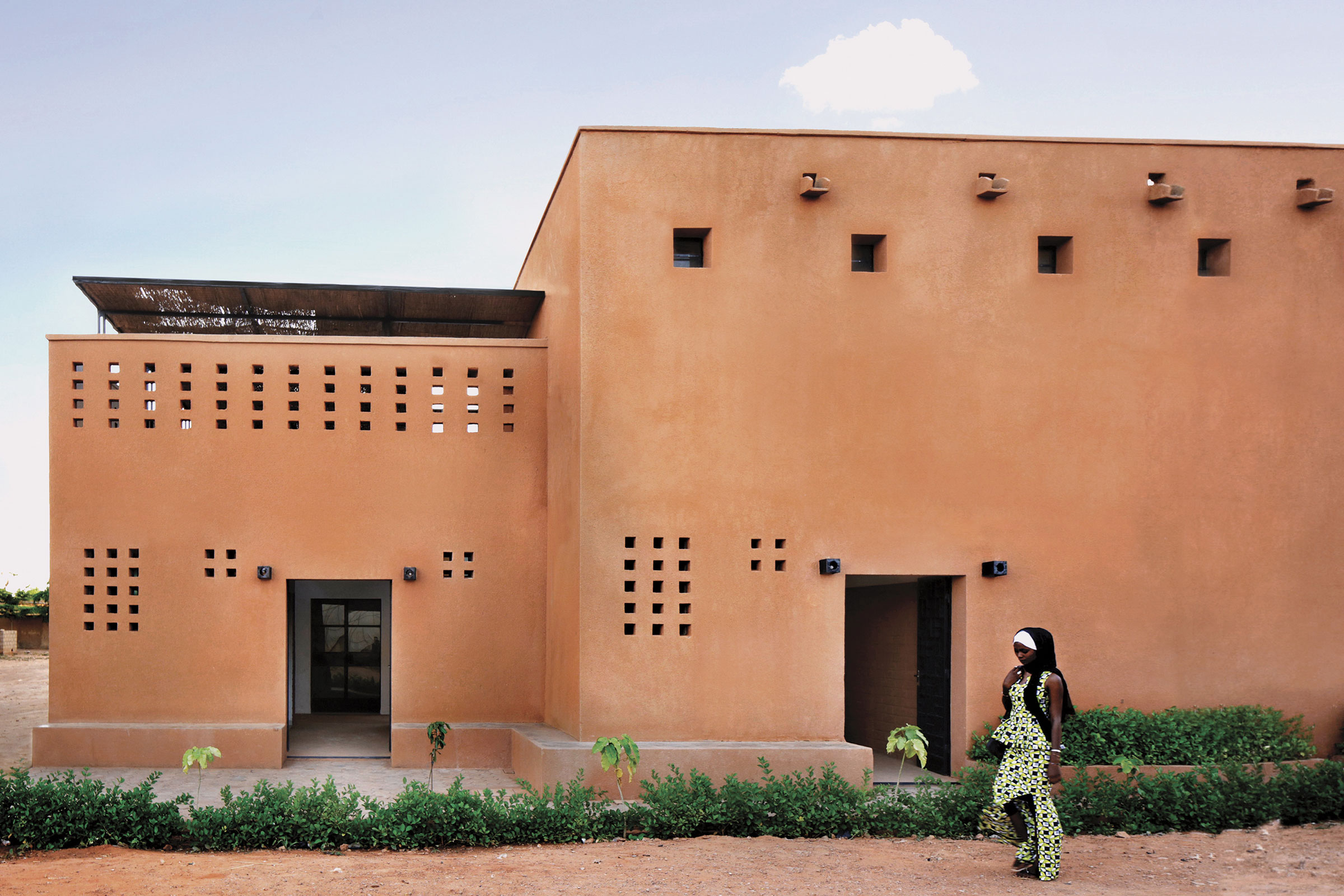
The Niamey 2000 housing project used compressed earth blocks as the primary building material. Photo by T. Seidel
Designed by United4Design in collaboration with Elizabeth Golden, AIA, the Niamey 2000 building in Niamey, Niger expertly showcases how local, easily sourced materials can be used to construct resilient and efficient climate responsive buildings.
Niger’s modern urban housing projects are heavily influenced by the low-density styles of Western architecture and make use of materials like cinder blocks, concrete, and metal fixtures. Because these materials often need to be imported, housing costs become inflated as a result.
In an effort to remedy this affordable housing crisis, United4Design cofounder and Niamey native Mariam Kamara turned to a simpler, more efficient solution—unfired earth bricks. Sourced and produced locally, these earthen bricks are cheaper to manufacture, provide work for skilled laborers, and possess inherent thermal properties that help passively regulate interior temperatures.
“Earth-based construction provides a buffer against outdoor temperature fluctuations, slowing the transmission of sub-Saharan heat, which is a distinct advantage over other contemporary systems currently in use in Niger,” Golden previously told gb&d. Niamey 2000 also employs several other passive cooling techniques, including breezeways and wind-driven ventilation inlets/outlets, to help circulate air without the aid of mechanical air conditioning.
Urban Frontier House, Billings, MT
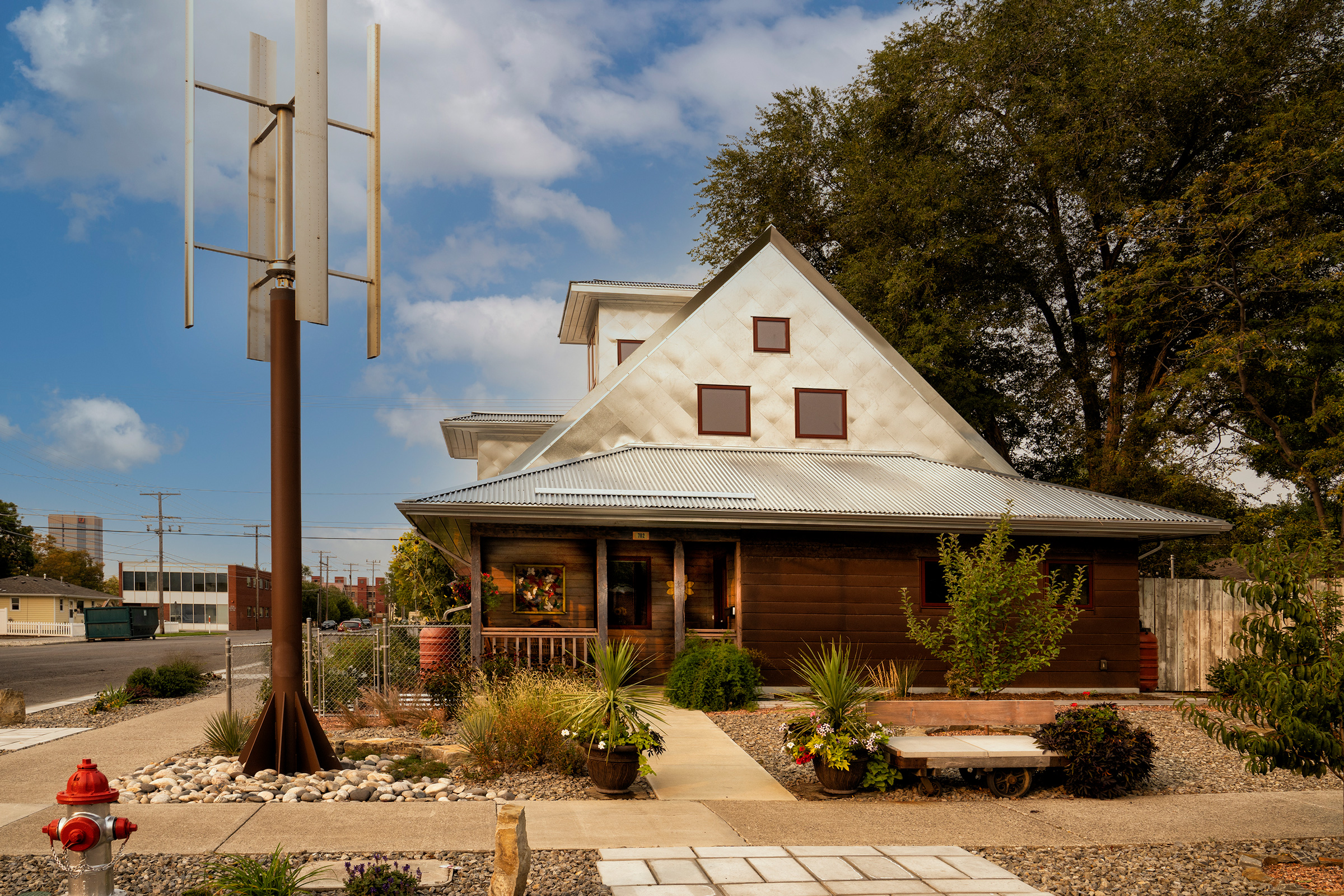
The LEED Platinum Urban Frontier House is a customized solution built by integrating existing systems in a new way to create a home that is scalable, replicable, and affordable. Photo by Clark Marten
Designed by High Plains Architects (HPA), the Urban Frontier House in Billings, Montana strives to be an affordable, replicable, and scalable model for climate responsive housing projects around the country.
Powered exclusively by wind and solar energy, the Urban Frontier House leverages the site’s natural phenomena to its full advantage, producing more energy that it uses in a year’s time and relying solely on harvested rainwater and snowmelt for its plumbing. To reduce the home’s embodied carbon footprint, locally-sourced, reclaimed, and renewable materials were used wherever possible.
One of the biggest challenges in designing the Urban Frontier House was ensuring that it was prepared to handle Montana’s extreme temperature fluctuations, which range between -36 and 108°F. Despite these extremes the home features no active heating or cooling but instead relies on abundant daylighting, blinds, natural ventilation, and a super insulated envelope made up of overlapping structural insulated panels to regulate heat gain/loss throughout the year.
“During Montana’s frigid winters, fresh air is circulated through the house using sun-warmed air from the garden room with the help of a 95% efficient Zehnder heat recovery ventilator,” Alex Tyler, marketing manager and project designer at HPA, wrote in a previous gb&d article. “To minimize the risk of freezing (a genuine concern during Montana’s winters), small radiant panels were installed as a last line of defense in key locations in some of the interior rooms.”
Cowboy Modern Desert Eco-Retreat, Pioneertown, CA
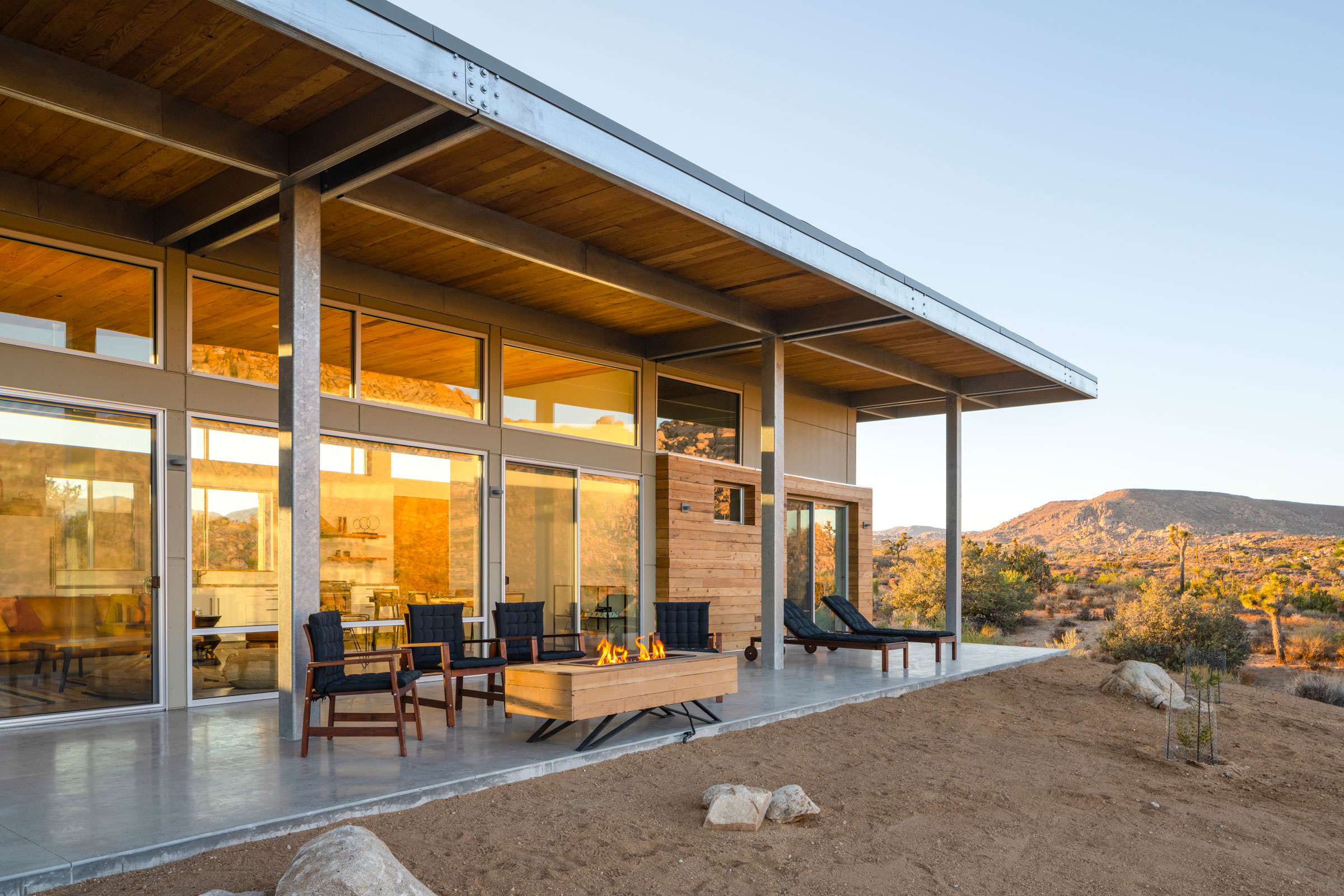
Designed by Jeremy Levine, the Cowboy Modern Desert Eco-Retreat uses passive solar design and wind-driven ventilation to reduce energy needs. Photo by Lance Gerber
Designed by Jeremy Levine Design, the Cowboy Modern Desert Eco-Retreat in Pioneertown, California is an excellent example of how climate responsive architecture can be implemented in hot, dry regions.
Deep in the Mojave desert, the retreat makes use of an open floor-plan and sliding glass doors to allow canyon winds to passively ventilate the building without the need for air conditioning. Other passive design features include the recycling of greywater for irrigation purposes.
The house itself takes the form of a simple rectangle and features a roof with a large overhang to provide ample shading while still allowing natural sunlight to filter in, eliminating the need for electric lighting during daytime hours. All wood used in the building’s construction was reclaimed from local demolition sites. Considering that reclaimed lumber typically has a lower moisture content than freshly cut wood, it is stronger and is less susceptible to damage caused by fluctuations in desert temperatures.
121 Seaport, Boston, MA
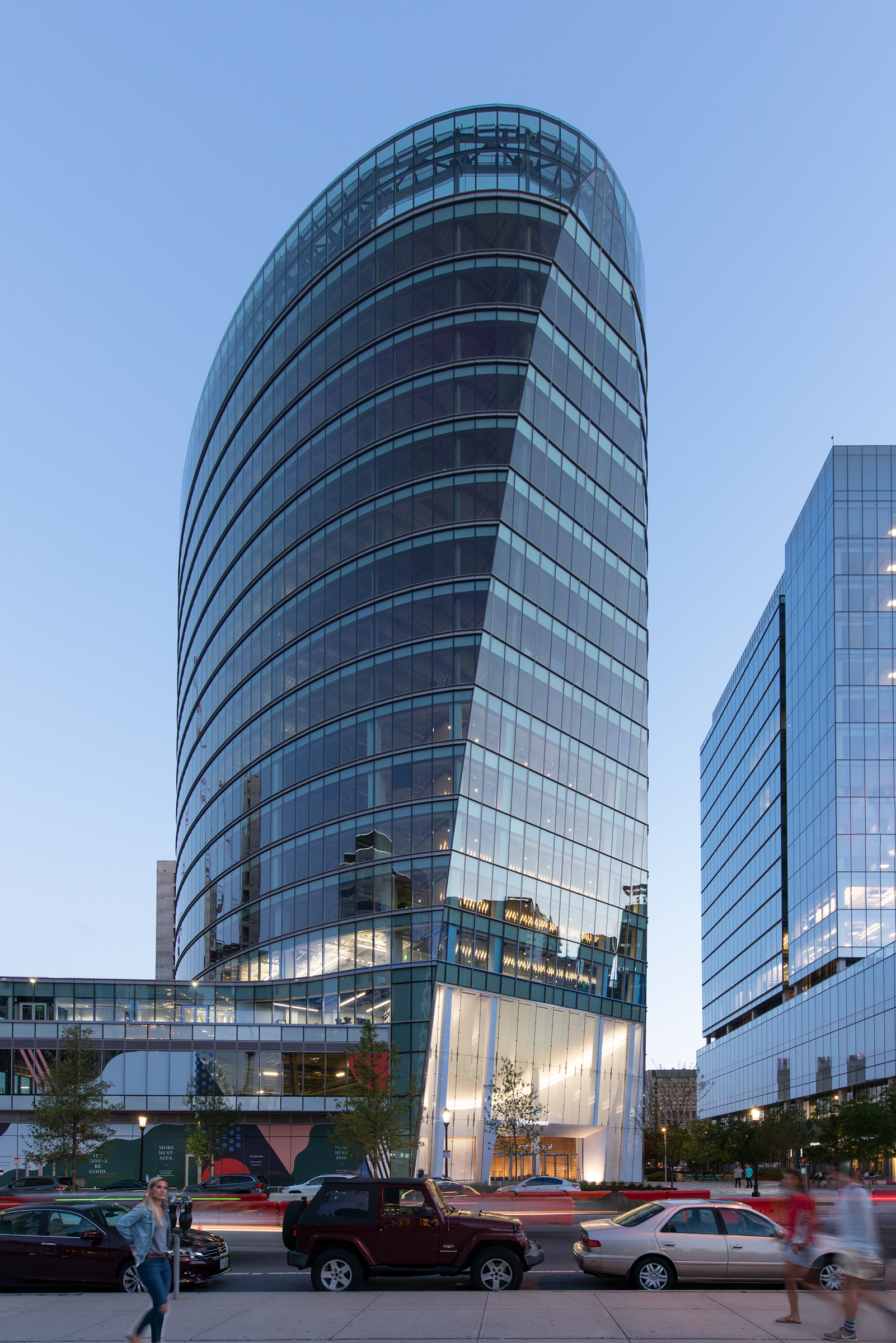
121 Seaport, designed by CBT. Photo by Chuck Choi
But climate responsive architecture isn’t limited to small-scale residences. It can also be realized in the form of skyscrapers and high-rises.
In Boston 121 Seaport is a 17-story office building designed by CBT that prioritizes sustainability and resilience in the face of adverse climatic events. Recognizable by its unique elliptical design, 121 Seaport is intentionally aligned so as to passively minimize solar heat gain—thereby reducing the need for electric air conditioning—and decrease stress from high winds.
“This building orientation also aligns with the prevailing wind direction, and its aerodynamic design reduces lateral wind force, decreasing the amount of structural reinforcement needed for the building by 30% and lowering the overall construction costs of the project,” David Nagahiro, principal architect at CBT, told gb&d in a previous interview.
121 Seaport also utilizes an energy-efficient chilled-beam system to circulate water—as opposed to air—to regulate temperatures when necessary and collects/recycles rainwater, reducing the building’s water consumption by 30%.
Binnacle Hill Residence, Kennebunkport, ME
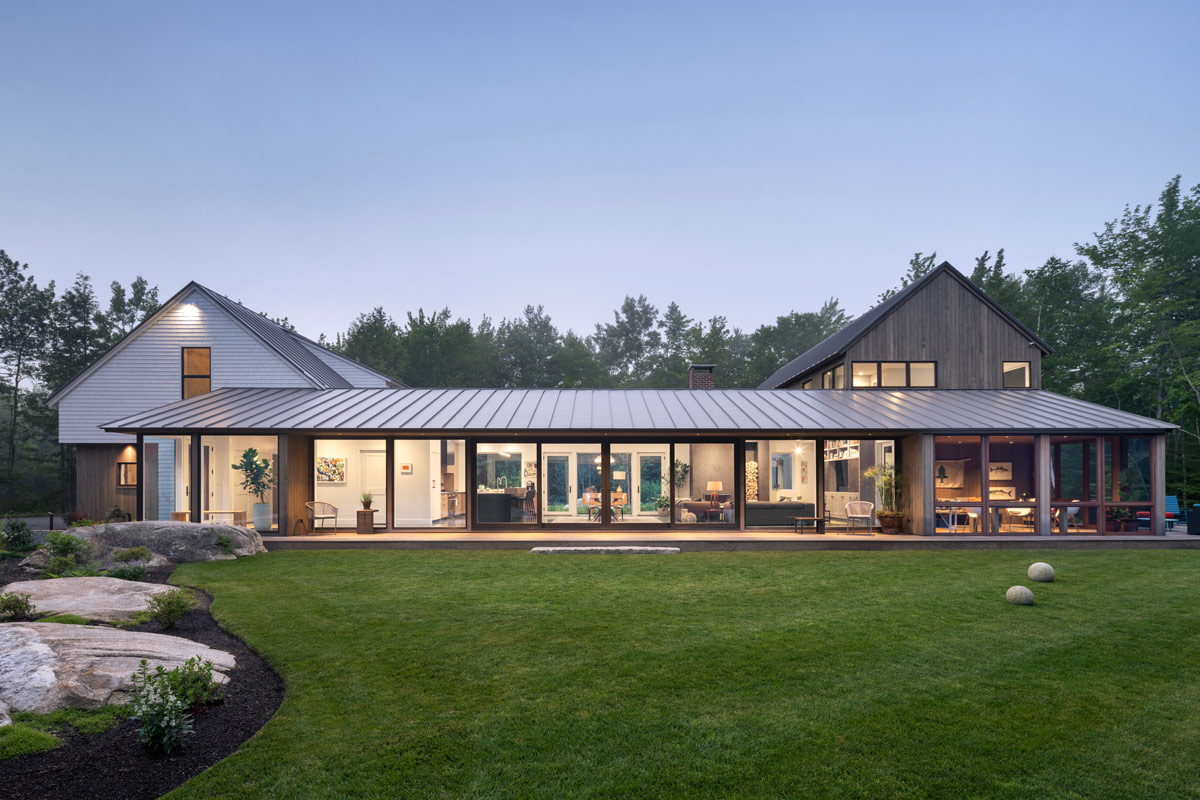
Whitten Architects’ site-specific approach for the Binnacle Hill Residence in Kennebunkport, Maine maximizes solar exposure and forms a connection with the surrounding wooded landscape. Photo by Trent Bell Photography
Completed in 2019 and designed by Whitten Architects, the Binnacle Hill Residence in Kennebunkport, Maine is a private family residence designed with the local climate in mind.
Located in a heavily wooded area, the Binnacle Hill House makes extensive use of passive solar design strategies to reduce heating and cooling loads. “Our site-specific design angled the house just east of south for ideal solar exposure, while the primary living space was situated toward a sunny lawn space against a wooded edge,” Jessie Carroll, associate principal and project architect at Whitten Architects, previously told gb&d.
South-facing windows were installed to allow natural daylight to illuminate the interior and an exterior soffit helps protect south-facing doors from the elements. The positioning of these features, combined with a high thermal mass polished concrete floor, promote passive solar gains during winter while limiting admittance of solar energy in summer.
Conclusion
Reducing the built environment’s production of carbon emissions is crucial to slowing (and eventually reversing) the detrimental effects of climate change. At the same time the structures we build must be capable of withstanding the increasingly frequent climate disasters we find ourselves facing—and climate responsive architecture is a convenient means of doing both at the same time.
Rather than perpetuate increasingly inefficient and ill-prepared universal architectural designs, climate responsive architecture recognizes that the local climatic and geographic characteristics of a region must be considered when designing efficient, resilient structures.



